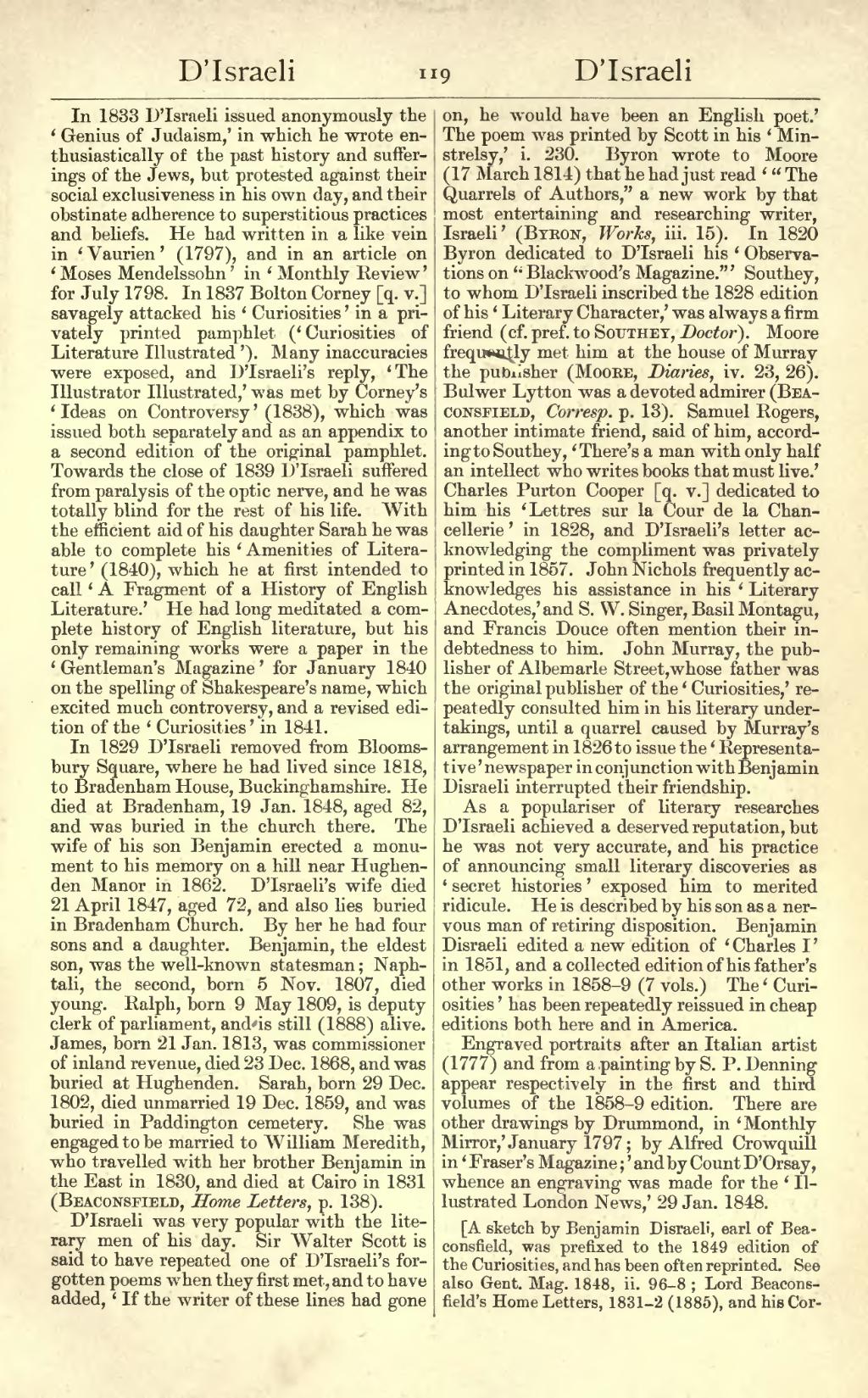In 1833 D'Israeli issued anonymously the ‘Genius of Judaism,’ in which he wrote enthusiastically of the past history and sufferings of the Jews, but protested against their social exclusiveness in his own day, and their obstinate adherence to superstitious practices and beliefs. He had written in a like vein in ‘Vaurien’ (1797), and in an article on ‘Moses Mendelssohn’ in ‘Monthly Review’ for July 1798. In 1837 Bolton Corney [q. v.] savagely attacked his ‘Curiosities’ in a privately printed pamphlet (‘Curiosities of Literature Illustrated’). Many inaccuracies were exposed, and D'Israeli's reply, ‘The Illustrator Illustrated,’ was met by Corney's ‘Ideas on Controversy’ (1838), which was issued both separately and as an appendix to a second edition of the original pamphlet. Towards the close of 1839 D'Israeli suffered from paralysis of the optic nerve, and he was totally blind for the rest of his life. With the efficient aid of his daughter Sarah he was able to complete his ‘Amenities of Literature’ (1840), which he at first intended to call ‘A Fragment of a History of English Literature.’ He had long meditated a complete history of English literature, but his only remaining works were a paper in the ‘Gentleman's Magazine’ for January 1840 on the spelling of Shakespeare's name, which excited much controversy, and a revised edition of the ‘Curiosities’ in 1841.
In 1829 D'Israeli removed from Bloomsbury Square, where he had lived since 1817, to Bradenham House, Buckinghamshire. He died at Bradenham, 19 Jan. 1848, aged 82, and was buried in the church there. The wife of his son Benjamin erected a monument to his memory on a hill near Hughenden Manor in 1862. D'Israeli's wife died 21 April 1847, aged 72, and also lies buried in Bradenham Church. By her he had four sons and a daughter. Benjamin, the eldest son, was the well-known statesman; Naphtali, the second, born 5 Nov. 1807, died young. Ralph, born 9 May 1809, was deputy clerk of parliament, and died 18 Oct. 1898, being buried in Hughenden churchyard. James, born 21 Jan. 1813, was commissioner of inland revenue, died 23 Dec. 1868, and was buried at Hughenden. Sarah, born 29 Dec. 1802, died unmarried 19 Dec. 1859, and was buried in Paddington cemetery. She was engaged to be married to William Meredith, who travelled with her brother Benjamin in the East in 1830, and died at Cairo in 1831 (Beaconsfield, Home Letters, p. 138).
D'Israeli was very popular with the literary men of his day. Sir Walter Scott is said to have repeated one of D'Israeli's forgotten poems when they first met, and to have added, ‘If the writer of these lines had gone on, he would have been an English poet.’ The poem was printed by Scott in his ‘Minstrelsy,’ i. 230. Byron wrote to Moore (17 March 1814) that he, had just read ‘“The Quarrels of Authors,” a new work by that most entertaining and researching writer, Israeli’ (Byron, Works, iii. 15). In 1820 Byron dedicated to D'Israeli his ‘Observations on “Blackwood's Magazine.”’ Southey, to whom D'Israeli inscribed the 1828 edition of his ‘Literary Character,’ was always a firm friend (cf. pref. to Southey, Doctor). Moore frequently met him at the house of Murray the publisher (Moore, Diaries, iv. 23, 26). Bulwer Lytton was a devoted admirer (Beaconsfield, Corresp. p. 13). Samuel Rogers, another intimate friend, said of him, according to Southey, ‘There's a man with only half an intellect who writes books that must live.’ Charles Purton Cooper [q. v.] dedicated to him his ‘Lettres sur la Cour de la Chancellerie’ in 1828, and D'Israeli's letter acknowledging the compliment was privately printed in 1857. John Nichols frequently acknowledges his assistance in his ‘Literary Anecdotes,’ and S. W. Singer, Basil Montagu, and Francis Douce often mention their indebtedness to him. John Murray, the publisher of Albemarle Street, whose father was the original publisher of the ‘Curiosities,’ repeatedly consulted him in his literary undertakings, until a quarrel caused by Murray's arrangement in 1826 to issue the ‘Representative’ newspaper in conjunction with Benjamin Disraeli interrupted their friendship.
As a populariser of literary researches D'Israeli achieved a deserved reputation. If not very accurate, he was learned and widely read. He is described by his son as a nervous man of retiring disposition. Benjamin Disraeli edited a new edition of ‘Charles I’ in 1851, and a collected edition of his father's other works in 1858–9 (7 vols.) The ‘Curiosities’ has been repeatedly reissued in cheap editions both here and in America.
Engraved portraits after an Italian artist (1777) and from a painting by S. P. Denning appear respectively in the first and third volumes of the 1858–9 edition. There are other drawings by Drummond, in ‘Monthly Mirror,’ January 1797; by Alfred Crowquill in ‘Fraser's Magazine;’ and by Count D'Orsay, whence an engraving was made for the ‘Illustrated London News,’ 29 Jan. 1848.
[A sketch by Benjamin Disraeli, earl of Beaconsfield, was prefixed to the 1849 edition of the Curiosities, and has been often reprinted. See also Gent. Mag. 1848, ii. 96–8; Lord Beaconsfield's Home Letters, 1831–2 (1885), and his Cor-
